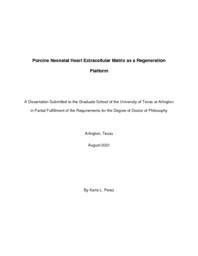| dc.description.abstract | Each year, an estimated 620,000 Americans have new heart attack and suffer from myocardial infarction (MI) that results in massive heart cell death and decrease in heart function. Various therapeutic strategies, such as pharmacological treatments and reperfusion strategies, have greatly improved short-term MI survival. However, these strategies do not restore normal cardiac function due to the permanent loss of cardiomyocytes. As a promising strategy, cardiac cell therapy delivers repairing cells to damaged areas (scar tissues) to revitalize the infracted heart. However, a key challenge in cardiac cell therapy, i.e. the extremely low survival and engraftment rate of transplanted cells, must be overcome before the tremendous power of cell therapy can be successfully exploited.
Biomaterials, such as polymeric/tissue-derived cardiac patches and injectable hydrogels, have been investigated as a means to provide mechanical supporting for MI, as well as to serve as a platform that triggers favorable cellular behavior and cardiac regeneration. Adult porcine myocardial scaffold as patch material and adult porcine myocardial extracellular matrix hydrogel as an injectable vehicle all showed potential in MI treatment. Recently, our in vivo neonatal pig model research demonstrated that the piglets would lose the fully regenerative potential by 7 days after birth, but greatly preserve the regenerative potential within 1 day of birth, pointing out the importance of biomechanical and biological cues of neonatal heart ECM in guiding cardiac full regeneration. We hence hypothesized that the 0-day neonatal heart extracellular matrix (ECM) microenvironment has biomechanical and biological cues that promote heart muscle regeneration, and the porcine neonatal heart ECM (nhECM) can be used as a biomaterial platform for MI treatment. Three aims were thus pursued to better understand the essential properties of nhECM and design two novel nhECM-based biomaterials. Aim 1: Structural and biomechanical characterizations of the acellular porcine neonatal heart ECM (nhECM). Aim 2: Porcine nhECM-based nanofibrous cardiac patch via electrospinning technique. Aim 3: Fabricating and characterizing porcine nhECM-based hydrogel as a cardiac injection material.
In Aim 1, we performed histological, compositional, and mechanical assessments to determine the structural-mechanical relationship of the nhECM. Histological observation and compositional quantification were carried out to understand ECM microstructure and composition. Biaxial mechanical testing, uniaxial mechanical testing, stress relaxation, and shear testing were performed to reveal a thorough biomechanical behavior of the porcine nhECM.
In Aim 2, we developed a novel nhECM-electrospinning protocol to engineer porcine nhECM-based nanofibrous cardiac patch. The concentration of nhECM, solvent, electrospinning parameters, and patch stabilizing crosslinking were investigated and optimized. The structure, mechanical properties, and biocompatibility of nhECM nanofibrous patch were assessed via SEM, biomechanical testing, and cell culture, respectively.
In Aim 3, we developed an effective protocol to reliably fabricate nhECM-based hydrogel. Structural and rheological tests were performed to determine the structure and porosity of nhECM hydrogel and its gelation kinetics. Additionally, cytotoxicity assessment and cell proliferation assay were carried out to assess the biocompatibility and cell growth potential of the nhECM hydrogel. | |


